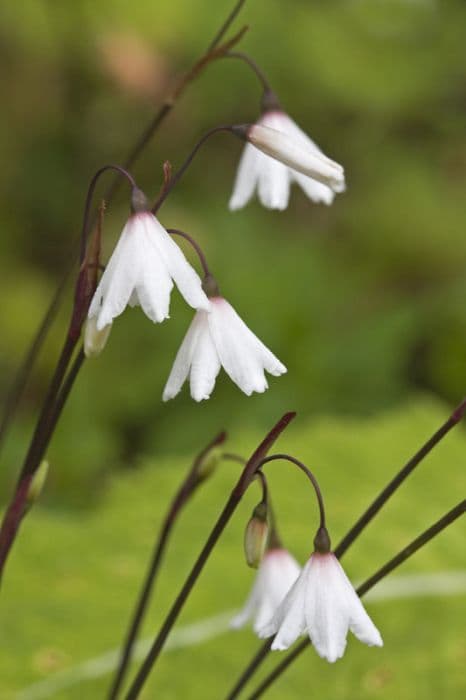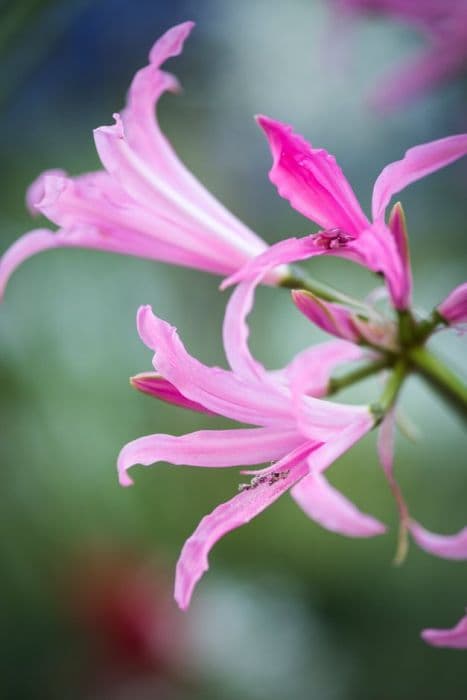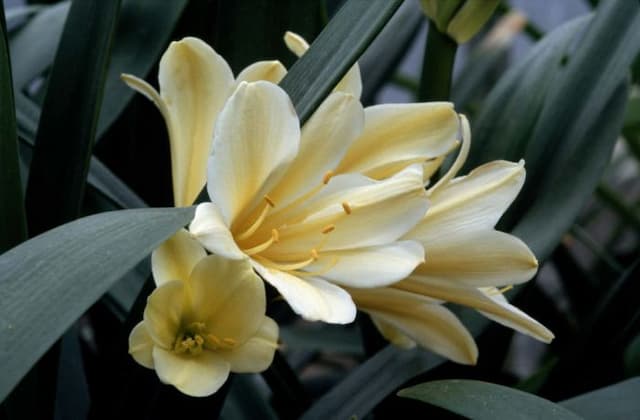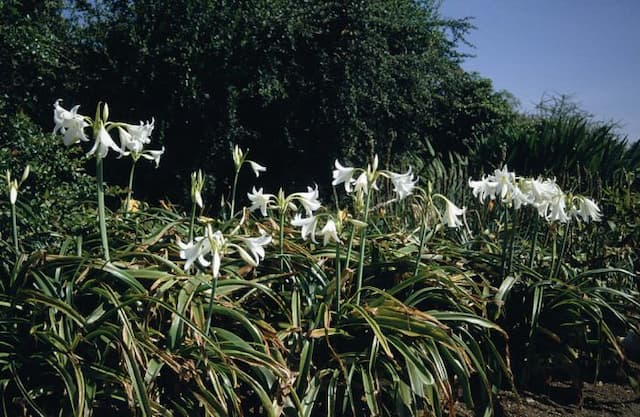Daffodil Narcissus 'Golden Vale' (1)

ABOUT
Narcissus 'Golden Vale' is an ornamental plant known for its striking flowers. This variety of daffodil showcases beautiful, trumpet-shaped blooms that are a radiant yellow, symbolizing the classic elegance associated with this popular spring-flowering bulb. The petals are often a paler shade of yellow, forming a backdrop for the deeper golden-yellow trumpet in the center. The trumpet of the Narcissus 'Golden Vale' can have a slightly frilled or ruffled edge, adding to its charm and giving it a lush, full appearance. The flowers are usually borne singly atop slender, upright stalks which emerge from the base of the plant's strap-like, green leaves. These leaves are long and narrow, creating a tuft of foliage that provides a contrasting green backdrop for the vivid blooms. The overall impression of the Narcissus 'Golden Vale' is one of cheer and brightness, with its sun-kissed flowers signaling the arrival of spring.
About this plant
 Names
NamesSynonyms
Daffodil, Jonquil, Narcissus.
Common names
Narcissus 'Golden Vale'
 Toxicity
ToxicityTo humans
Daffodil is a plant that is toxic to humans if ingested. All parts of the plant contain toxic alkaloids, with the bulb being the most poisonous part. If someone eats any part of a daffodil, they may experience symptoms including nausea, vomiting, abdominal pain, and diarrhea. In severe cases, daffodil poisoning can lead to more serious effects such as cardiac arrhythmias, low blood pressure, tremors, and even seizures. It is important to keep daffodils out of reach of children and to instruct them not to eat any part of the plant.
To pets
Daffodil is also toxic to pets and can cause similar symptoms as in humans if ingested. The entire plant is poisonous, but the bulb is particularly dangerous. If a pet consumes daffodil, they may exhibit signs of toxicity such as vomiting, diarrhea, abdominal pain, hypersalivation, and even cardiac arrhythmias or respiratory depression in severe cases. It is critical to prevent pets from accessing any part of daffodils and to seek veterinary care immediately if you suspect your pet has ingested this plant.
 Characteristics
CharacteristicsLife cycle
Perennials
Foliage type
Deciduous
Color of leaves
Green
Flower color
Yellow
Height
1-1.5 feet (30-45 cm)
Spread
0.5 feet (15 cm)
Plant type
Bulb
Hardiness zones
3-9
Native area
Europe
Benefits
 General Benefits
General Benefits- Ornamental Appeal: The Narcissus 'Golden Vale', commonly known as daffodil, bears attractive yellow flowers that enhance the aesthetics of gardens and landscapes.
- Ease of Care: Daffodils are low maintenance, requiring minimal care once planted, making them suitable for novice gardeners.
- Pest Resistance: Daffodils are generally resistant to pests and deer, which helps to avoid the need for pesticides and keeps gardens eco-friendly.
- Naturalizing: Daffodils have the ability to naturalize, meaning they can spread and propagate on their own, creating larger displays over time.
- Spring Bloom: They are among the first flowers to bloom in spring, providing early color and a sign of the warm season to come.
- Cut Flower Use: Daffodils are excellent for cut flower arrangements, lasting well in vases and bringing cheer indoors.
- Hardiness: These plants are hardy in a wide range of climates and can withstand cold temperatures, making them suitable for many growing zones.
- Diversity: There is a variety of shapes and sizes among daffodils, allowing for diverse design and planting schemes in the garden.
 Medical Properties
Medical PropertiesThis plant is not used for medical purposes.
 Air-purifying Qualities
Air-purifying QualitiesThis plant is not specifically known for air purifying qualities.
 Other Uses
Other Uses- Photography subjects: Daffodil 'Golden Vale' can be a beautiful subject for macro photography due to its vibrant colors and intricate flower structure.
- Eco-friendly dye: The petals of daffodils can be used to create a natural yellow dye for textiles, though it is not a common practice.
- Pond filtration: Daffodil roots are sometimes used in constructed wetlands or garden ponds for their ability to help filter and clean the water.
- Artistic inspiration: The vibrant yellow of 'Golden Vale' daffodils can be used by artists as a muse for paintings, drawings, and other visual arts.
- Floral water: Daffodils can be steeped in water to create a floral-scented water that might be used for cosmetic purposes like a refreshing face spritz; however, caution should be taken due to the potential toxicity of daffodils.
- Memory gardens: Planting daffodils like 'Golden Vale' can serve as a living memorial to a loved one or an event, as these flowers return each year.
- Garden pest repellent: While not widely documented, some gardeners believe that daffodils may help to repel certain garden pests like rodents due to their toxicity.
- Cut flower arrangements: Daffodils are commonly used in bouquet arrangements and can be paired with other spring flowers to create visually appealing designs.
- Plant competitions: Horticulturists and garden enthusiasts may grow 'Golden Vale' daffodils to enter into plant or flower show competitions due to their striking appearance.
- Decorative wreaths: Daffodil flowers can be dried and incorporated into decorative wreaths and arrangements for spring-themed decor.
Interesting Facts
 Feng Shui
Feng ShuiThe Daffodil is not used in Feng Shui practice.
 Zodiac Sign Compitability
Zodiac Sign CompitabilityThe Daffodil is not used in astrology practice.
 Plant Symbolism
Plant Symbolism- Rebirth and New Beginnings: The Narcissus 'Golden Vale', commonly known as Daffodil, often blooms in early spring, symbolizing the end of winter and the arrival of a new life or fresh start.
- Unrequited Love: In reference to the Greek myth of Narcissus, daffodils can symbolize self-love and vanity, but also the sorrow of love that is not reciprocated.
- Chivalry: Due to their bright and vibrant appearance that seems to stand out in the landscape, daffodils have been connected with noble or gallant behavior.
- Hope: Daffodils are often seen as a sign of hope and encouragement, their bright yellow color reminiscent of a sunny outlook and positive future.
- Prosperity: Particularly in the East, daffodils are believed to bring good fortune and are associated with prosperity and wealth.
 Water
WaterDaffodils should be watered deeply to encourage root growth and during their growing season, generally in the fall, you should provide about an inch of water each week, which equates to approximately 0.623 gallons per square yard. After they bloom in the spring, reduce watering as they enter dormancy. Be careful not to overwater, as this can lead to bulb rot.
 Light
LightDaffodils thrive in full to partial sunlight, needing a minimum of 6 hours of direct sunlight each day. The ideal spot for planting daffodils would be an area that receives morning sun and afternoon shade, as intense afternoon sunlight can be harmful, especially in warmer climates.
 Temperature
TemperatureDaffodils can survive a wide range of temperatures but grow best between 50 and 60 degrees Fahrenheit. They are hardy and can withstand winter temperatures down to about 20 degrees Fahrenheit but should be protected if temperatures consistently fall below this range. Their ability to tolerate cold is what makes them ideal for spring flowering.
 Pruning
PruningDeadheading daffodils after blooming by removing the flower heads promotes healthier bulbs and prevents seed formation. However, do not remove the foliage until it has turned yellow and died back naturally, as the leaves are required to gather energy for the next growing season. Pruning is typically done annually right after flowering.
 Cleaning
CleaningNot needed
 Soil
SoilDaffodil 'Golden Vale' prefers well-draining soil with a pH between 6.0 and 7.0. A mixture of loamy soil, peat moss, and sand works well to ensure adequate drainage and fertility for optimal growth.
 Repotting
RepottingDaffodils, including 'Golden Vale', generally do not need to be repotted if they are planted in the ground. In containers, repot them every 2-3 years or when they become overcrowded.
 Humidity & Misting
Humidity & MistingDaffodil 'Golden Vale' is tolerant of a wide range of humidity conditions and does not require specific humidity levels to thrive.
 Suitable locations
Suitable locationsIndoor
Place Golden Vale daffodils in a bright spot with cool temperatures.
Outdoor
Plant Golden Vale daffodils in full sun to partial shade.
Hardiness zone
3-9 USDA
 Life cycle
Life cycleNarcissus 'Golden Vale', commonly known as Daffodil, begins its life cycle as a bulb lying dormant beneath the soil surface, usually during summer when the plant is not actively growing. As temperatures cool in autumn, roots begin to develop, preparing the plant for winter. Through the winter, the bulb stores energy, and come spring, the bulb sends up shoots that develop into distinctive green stalks and leaves, with the flower bud emerging and blooming into the characteristic yellow or golden trumpet-shaped flower. After flowering in spring, the plant undergoes photosynthesis to replenish the bulb's energy reserves before the foliage dies back. The leaves should remain until they turn yellow and wither, as premature removal can weaken the bulb. The cycle repeats yearly, with the bulb entering a dormant stage after foliage dies back and awaiting the next cool autumn to restart the growth process.
 Propogation
PropogationPropogation time
Spring-Early Summer
The most popular method of propagating Narcissus 'Golden Vale', commonly known as daffodil, involves dividing and replanting the bulbs. This is typically done in the late summer to early fall, after the foliage has died back. Gardeners should carefully dig up the bulbs, trying not to damage them, and gently separate any bulb offsets, which are smaller bulbs attached to the parent bulb. These offsets can be replanted immediately, at a depth three times the height of the bulb, usually around 6 inches deep (approximately 15 cm), in well-drained soil. By the following spring, these new plantings should develop into flowering plants.









